The Early Silurian Gabbro in the Eastern Kunlun Orogenic Belt, Northeast Tibet: Constraints on the Proto-Tethyan Ocean Closure
Abstract
1. Introduction
2. Regional Geological Setting
3. Analytical Methods
3.1. Major and Trace Elements
3.2. Zircon U–Pb Dating
3.3. Zircon Hf Isotopic Analysis
4. Analytical Results
4.1. Whole-Rock Geochemistry
4.2. Zircon U–Pb Ages
4.3. Zircon Lu–Hf Isotopic Compositions
5. Discussion
5.1. Fractional Crystallization and Crustal Contamination
5.2. Nature of the Mantle Source
5.3. Implications for the Early Silurian Tectonic Nature of the EKOB
6. Conclusions
Author Contributions
Funding
Acknowledgments
Conflicts of Interest
References
- Chen, N.; Sun, M.; Wang, Q.; Zhao, G.; Chen, Q.; Shu, G. EMP chemical ages of monazites from Central Zone of the eastern Kunlun Orogen: Records of multi-tectonometamorphic events. Chin. Sci. Bull. 2007, 52, 2252–2263. [Google Scholar] [CrossRef]
- Bian, Q.T.; Li, D.H.; Pospelov, I.; Yin, L.M.; Li, H.S.; Zhao, D.S.; Chang, C.F.; Luo, X.Q.; Gao, S.L.; Astrakhantsev, O.; et al. Age, geochemistry and tectonic setting of Buqingshan ophiolites, North Qinghai-Tibet Plateau, China. J. Asian Earth Sci. 2004, 23, 577–596. [Google Scholar] [CrossRef]
- Yang, J.S.; Robinson, P.; Jiang, C.F.; Xu, Z.Q. Ophiolites of the Kunlun Mountains, China and their tectonic implications. Tectonophysics 1996, 258, 215–231. [Google Scholar] [CrossRef]
- Lu, N.S.; Yu, H.F.; Zhao, F.Q. Precambrian Geology in Northern Tibetan Plateau; Geological Publishing House: Beijing, China, 2002. [Google Scholar]
- Lu, L.; Zhang, Y.; Wu, Z.; Hu, D. Zircon U-Pb dating of Early Paleozoic granites from the East Kunlun Mountains and its geological significance. Acta Geosci. Sin. 2013, 34, 447–454. [Google Scholar]
- Zhang, J.Y.; Ma, C.Q.; Xiong, F.H.; Liu, B. Petrogenesis and tectonic significance of the Late Permian–Middle Triassic calc-alkaline granites in the Balong region, eastern Kunlun Orogen, China. Geol. Mag. 2012, 149, 892–908. [Google Scholar] [CrossRef]
- Zhu, Y.; Lin, Q.; Jia, C.; Wang, G. SHRIMP zircon U-Pb age and significance of Early Paleozoic volcanic rocks in East Kunlun orogenic belt, Qinghai Province, China. Sci. China Ser. D Earth Sci. 2006, 49, 88–96. [Google Scholar] [CrossRef]
- Dong, Y.; He, D.; Sun, S.; Liu, X.; Zhou, X.; Zhang, F.; Yang, Z.; Cheng, B.; Zhao, G.; Li, J. Subduction and accretionary tectonics of the East Kunlun orogen, western segment of the Central China Orogenic System. Earth Sci. Rev. 2018, 186, 231–261. [Google Scholar] [CrossRef]
- Zhou, B.; Dong, Y.; Zhang, F.; Yang, Z.; Sun, S.; He, D. Geochemistry and zircon U-Pb geochronology of granitoids in the East Kunlun Orogenic Belt, northern Tibetan Plateau: Origin and tectonic implications. J. Asian Earth Sci. 2016, 130, 265–281. [Google Scholar] [CrossRef]
- Liu, B.; Ma, C.; Jiang, H.; Guo, P.; Zhang, J.; Xiong, F. Early Paleozoic tectonic transition from ocean subduction to collisional orogeny in the Eastern Kunlun region: Evidence from Huxiaoqin mafic rocks. Acta Petrol. Sin. 2013, 29, 2093–2106. [Google Scholar]
- Hao, N.N.; Yuan, W.M.; Zhang, A.K.; Cao, J.H.; Chen, X.N.; Feng, Y.L.; Li, X. Late Silurian to Early Devonian granitoids in the Qimantage Area, East Kunlun Mountains: LA-ICPMS zircon U–Pb ages, geochemical features and geological setting. Geol. Rev. 2014, 60, 201–215. [Google Scholar]
- Li, B.L.; Sun, F.Y.; Yu, X.F.; Qian, Y.; Wang, G.; Yang, Y.Q. U-Pb dating and geochemistry of diorite in the eastern section from eastern Kunlun middle uplifted basement and granitic belt. Acta Petrol. Sin. 2012, 28, 1163–1172. [Google Scholar]
- Lu, L.; Wu, Z.; Hu, D.; Barosh, P.J.; Hao, S.; Zhou, C. Zircon U-Pb age for rhyolite of the Maoniushan Formation and its tectonic significance in the East Kunlun Mountains. Acta Petrol. Sin. 2010, 26, 1150–1158. [Google Scholar]
- Du, W.; Jiang, C.; Ling, J.; Zhou, W.; Xia, M.; Xia, Z. Zircon SHRIMP U-Pb geochronology, geochemistry and implications of No.Ⅱ intrusion in Xiarihamu Cu-Ni deposit, East Kunlun Mountains. Miner. Depos. 2017, 36, 1185–1196. [Google Scholar]
- Zhang, Z.; Wang, C.; Qian, B.; Li, W. The geochemistry characteristics of Silurian gabbro in East Kunlun Orogenic Belt and its mineralization relationship with magmatic Ni-Cu sulfide deposit. Acta Petrol. Sin. 2018, 34, 2262–2274. [Google Scholar]
- Pan, G.T.; Li, X.Z.; Wang, L.Q.; Ding, J.; Chen, Z.L. Preliminary division of tectonic nits of the Qinghai-Tibet Plateau and its adjacent regions. Geol. Bull. China 2002, 21, 701–707. [Google Scholar]
- Xu, Z.Q.; Yang, J.S.; Li, H.B.; Zhang, J.X.; Zeng, L.S.; Jiang, M. The Qinghai-Tibet plateau and continental dynamics: A review on terrain tectonics, collisional orogenesis, and processes and mechanisms for the rise of plateau. Geol. China 2006, 33, 221–238. [Google Scholar]
- Yin, F.H.; Zhang, K.X. Characteristics of the easrern Kunlun orogenic belt. Earth Sci. 1997, 22, 339–342. [Google Scholar]
- Fan, L.K.; Cai, Y.P.; Liang, H.P.; Li, H.L. Characters and Evolution of the Geodynamics in the East Kunlun. Geol. Surv. Res. 2009, 32, 181–186. [Google Scholar]
- Shen, Y.C.; Yang, J.Z.; Liu, T.B.; Li, G.M.; Zeng, Q.D. The discovery of ophioite in the Qimantha area, East Kunlun, Xinjiang, China. Geol. Rev. 2000, 46, 92. [Google Scholar]
- Zhu, Y.H.; Zhang, K.X.; Yuan, P.; Chen, N.S.; Wang, G.C.; Hou, G.J. Determination of different ophiolitic belts in eastern Kunlun orogenic zone and their tectonic significance. Earth Sci. J. China Univ. Geosci. 1999, 24, 134–138. [Google Scholar]
- Qi, X.P.; Yang, J.; Fan, X.G.; Cui, J.T.; Cai, Z.F.; Zeng, X.W.; Wei, W.; Qu, X.X.; Zhai, Y.M. Age, geochemical characteristics and tectonic significance of Changshishan ophiolite in central East Kunlun tectonic mélange belt along the east section of East Kunlun Mountains. Geol. China 2016, 43, 797–816. [Google Scholar]
- Bian, Q.T.; Luo, X.Q.; Li, H.S.; Zhao, D.S. Discovery of Early Paleozoic and Early Carboniferous-Early Permian ophiolites in the Animaqing, Qinghai, China. Sci. Geol. Sin. 1999, 34, 523–524. [Google Scholar]
- Gao, L.Y.; Wu, X.N.; Zuo, G.C. The Characters and Tectonic Significance of Ophiolite First Discovered in Qinshuiquan Area, East Kunlun; Chinese Academy of Geological Sciences, Xi’an Institute of Geology and Mineral Resources: Xi’an, China, 1988. [Google Scholar]
- Jiang, C.F.; Yang, J.S.; Feng, B.G.; Zhu, Z.Z.; Zhao, M.; Chai, Y.C.; Shi, X.D.; Wang, H.D.; Hu, J.Q. Opening-Closing Tectonics of Kunlun Mountains; Geological Publishing House: Beijing, China, 1992. [Google Scholar]
- Meng, F.; Zhang, J.; Cui, M. Discovery of Early Paleozoic eclogite from the East Kunlun, Western China and its tectonic significance. Gondwana Res. 2013, 23, 825–836. [Google Scholar] [CrossRef]
- Meng, F.C.; Cui, M.H.; Jia, L.H.; Ren, Y.F.; Feng, H.B. Paleozoic continental collision of the East Kunlun orogen: Evidence from protoliths of the eclogites. Acta Petrol. Sin. 2015, 31, 3581–3594. [Google Scholar]
- Qi, S.S.; Song, S.G.; Shi, L.C.; Cai, H.J.; Hu, J.C. Discovery and its geological significance of Early Paleozoic eclogite in Xiarihamu-Suhaitu area, western part of the East Kunlun. Acta Petrol. Sin. 2014, 30, 3345–3356. [Google Scholar]
- Qi, X.P.; Fan, X.G.; Yang, J.; Cui, J.T.; Wang, B.Y.; Fan, Y.Z. The discovery of Early Paleozoic eclogite in the upper reaches of Langmuri in eastern East Kunlun Mountains and its significance. Geol. Bull. China 2016, 35, 1771–1783. [Google Scholar]
- Gu, F.B. Geological characteristics of East Kunlun and tectonic evolution in late Paleozic-Mesozoic Era. Geol. Qinghai 1994, 1, 4–14. [Google Scholar]
- Li, H.K.; Lu, S.N.; Xiang, Z.Q.; Zhou, H.Y.; Guo, H.; Song, B.; Zheng, J.K.; Gu, Y. SHRIMP U-Pb zircon age of the granulate from the Qingshuiquan area, Central Eastern Kunlun Suture Zone. Earth Sci. Front. 2006, 13, 311–321. [Google Scholar]
- Wu, J.G.; Xiao, X.C.; Li, T.D. The Yadong-Golmud geoscience section on the Qinghai-Tibet Plateau. Acta Geol. Sin. 1989, 63, 285–296. [Google Scholar]
- Mo, X.X.; Luo, Z.H.; Deng, J.F.; Yu, X.H.; Liu, C.D.; Chen, H.W.; Liu, H.Y. Granitoids and Crustal Crowth in the East Kunlun Orogenic Belt. Geol. J. China Univ. 2007, 13, 403–414. [Google Scholar]
- Chen, N. Precise timing of the Early Paleozoic metamorphism and thrust deformation in the Eastern Kunlun Orogen. Chin. Sci. Bull. 2002, 47, 1130. [Google Scholar] [CrossRef]
- Xu, W.L.; Wang, Q.H.; Wang, D.Y.; Guo, J.H.; Pei, F.P. Mesozoic adakitic rocks from the Xuzhou–Suzhou area, eastern China: Evidence for partial melting of delaminated lower continental crust. J. Asian Earth Sci. 2006, 27, 230–240. [Google Scholar] [CrossRef]
- Chen, Y.X.; Pei, X.Z.; Li, R.B.; Liu, Z.Q.; Li, Z.C.; Zhang, X.F.; Chen, G.C.; Liu, Z.G.; Ding, S.P.; Guo, J.F. Zircon U-Pb Age of Xiaomiao Formation of Proterozoic in the Eastern Section of the East Kunlun Orogenic Belt. Geoscience 2011, 25, 510–521. [Google Scholar]
- Wang, G.C.; Wei, Q.R.; Jia, X.Y.; Zhang, K.X.; Li, D.W.; Zhu, Y.H.; Xiang, S.Y. Some ideas of Precambrian Geology in the East Kunlun, China. Geol. Bull China 2007, 26, 929–937. [Google Scholar]
- Cui, H.M.; Meng, F.C.; Wu, X.K. Early Ordovician island arc of Yaziquan, west of Qimantag Mountain, East Kunlun: Evidences from geochemistry, Sm-Nd isotope and geochronology of intermediate-basic rocks. Acta Petrol. Sin. 2011, 27, 3365–3379. [Google Scholar]
- Feng, C.Y.; Wang, X.P.; Shu, X.F.; Zhang, A.K.; Ye, X.; Liu, J.N.; Ma, S.C.; Li, G.C.; Li, D.X. Isotopic Chronology of the Hutouya Skarn Lead-Zinc Polymetailic Ore District in Qimantage Area of Qinghai Province and Its Geological Significance. J. Jilin 2011, 41, 1806–1817. [Google Scholar]
- Wiedenbeck, M.; Allé, P.; Corfu, F.; Griffin, W.L.; Meier, M.; Oberli, F.; Von Quadt, A.; Roddick, J.; Spiegel, W. Three natural zircon standards for the U-Th-Pb, Lu-Hf, trace element and ree analyses. Geostand. Geoanal. Res. 1995, 19, 1–23. [Google Scholar] [CrossRef]
- Jackson, S.E.; Pearson, N.J.; Griffin, W.L.; Belousova, E.A. The application of laser ablation-inductively coupled plasma-mass spectrometry to in situ U–Pb zircon geochronology. Chem. Geol. 2004, 211, 47–69. [Google Scholar] [CrossRef]
- Yuan, H.; Gao, S.; Liu, X.; Li, H.; Günther, D.; Wu, F. Accurate U-Pb Age and Trace Element Determinations of Zircon by Laser Ablation-Inductively Coupled Plasma-Mass Spectrometry. Geostand. Geoanal. Res. 2004, 28, 353–370. [Google Scholar] [CrossRef]
- Hu, Z.; Zhang, W.; Liu, Y.; Gao, S.; Li, M.; Zong, K.; Chen, H.; Hu, S. “Wave” Signal-Smoothing and Mercury-Removing Device for Laser Ablation Quadrupole and Multiple Collector ICPMS Analysis: Application to Lead Isotope Analysis. Anal. Chem. 2014, 87, 1152–1157. [Google Scholar] [CrossRef]
- Andersen, T. Correction of common lead in U–Pb analyses that do not report 204Pb. Chem. Geol. 2002, 192, 59–79. [Google Scholar] [CrossRef]
- Liu, Y.; Gao, S.; Hu, Z.; Gao, C.; Zong, K.; Wang, D. Continental and Oceanic Crust Recycling-induced Melt-Peridotite Interactions in the Trans-North China Orogen: U-Pb Dating, Hf Isotopes and Trace Elements in Zircons from Mantle Xenoliths. J. Pet. 2009, 51, 537–571. [Google Scholar] [CrossRef]
- Liu, Y.; Hu, Z.; Gao, S.; Günther, D.; Xu, J.; Gao, C.; Chen, H. In situ analysis of major and trace elements of anhydrous minerals by LA-ICP-MS without applying an internal standard. Chem. Geol. 2008, 257, 34–43. [Google Scholar] [CrossRef]
- Ludwig, K.R. Isoplot 3.00: A Geochronological Toolkit for Microsoft Excel; Berkeley Geochronology Center Special Publication; BGC: Berkeley, CA, USA, 2003; Volume 4, p. 70. [Google Scholar]
- Wu, F.; Yang, Y.-H.; Xie, L.-W.; Yang, J.-H.; Xu, P. Hf isotopic compositions of the standard zircons and baddeleyites used in U–Pb geochronology. Chem. Geol. 2006, 234, 105–126. [Google Scholar] [CrossRef]
- Lu, Y.F. Geokit—A geochemical toolkit for Microsoft Excel. Geochimica 2004, 33, 459–464. [Google Scholar]
- Middlemost, E.A. Naming materials in the magma/igneous rock system. Earth Sci. Rev. 1994, 37, 215–224. [Google Scholar] [CrossRef]
- Winchester, J.; Floyd, P. Geochemical discrimination of different magma series and their differentiation products using immobile elements. Chem. Geol. 1977, 20, 325–343. [Google Scholar] [CrossRef]
- Pearce, J.A. Trace element characteristics of lavas from destructive plate boundaries. Andesites 1982, 8, 525–548. [Google Scholar]
- Coleman, R.G.; Engelhardt, W. What Is an Ophiolite? Springer Science and Business Media LLC: Berlin/Heidelberg, Germany, 1977; pp. 1–7. [Google Scholar]
- Taylor, S.R.; McLennan, S.M. The Continental Crust: Its Composition and Evolution; Blackwell: Oxford, UK, 1985. [Google Scholar]
- Sun, S.S.; McDonough, W.F. Chemical and isotopic systematics of oceanic basalts: Implications for mantle composition and processes. Geol. Soc. London Spéc. Publ. 1989, 42, 313–345. [Google Scholar] [CrossRef]
- Niu, Y.; O’Hara, M.J. Origin of ocean island basalts: A new perspective from petrology, geochemistry, and mineral physics considerations. J. Geophys. Res. Space Phys. 2003, 108, B4. [Google Scholar] [CrossRef]
- Liu, B.; Ma, C.; Zhang, J.; Xiong, F.; Huang, J.; Jiang, H. Petrogenesis of Early Devonian intrusive rocks in the east part of Eastern Kunlun Orogen and implication for Early Palaeozoic orogenic processes. Acta Petrol. Sin. 2012, 28, 1785–1807. [Google Scholar]
- Belousova, E.A.; Griffin, W.L.; Pearson, N.J. Trace element composition and cathodoluminescence properties of southern African kimberlitic zircons. Miner. Mag. 1998, 62, 355–366. [Google Scholar] [CrossRef]
- Belousova, E.A.; Griffin, W.L.; O’Reilly, S.Y. Zircon Crystal Morphology, Trace Element Signatures and Hf Isotope Composition as a Tool for Petrogenetic Modelling: Examples from Eastern Australian Granitoids. J. Pet. 2005, 47, 329–353. [Google Scholar] [CrossRef]
- Belousova, E.A.; Griffin, W.L.; O’Reilly, S.Y.; Fisher, N. Igneous zircon: Trace element composition as an indicator of source rock type. Contrib. Miner. Pet. 2002, 143, 602–622. [Google Scholar] [CrossRef]
- Kirkland, C.L.; Smithies, R.; Taylor, R.; Evans, N.; McDonald, B. Zircon Th/U ratios in magmatic environs. Lithos 2015, 212, 397–414. [Google Scholar] [CrossRef]
- Stacey, J.S.; Kramers, J.D. Approximation of terrestrial lead isotope evolution by a two-stage model. Earth Planet. Sci. Lett. 1975, 26, 207–221. [Google Scholar] [CrossRef]
- Wu, F.Y.; Li, X.H.; Zheng, Y.F.; Gao, S. Lu-Hf isotopic systematics and their applications in petrology. Acta Petrol. Sin. 2007, 23, 185–220. [Google Scholar]
- Xu, J.; Zhou, W.; Zhao, X.; Wang, B.; Li, H.; Chang, F.; XinBiao, L. Zircon U-Pb age and Hf isotopic characteristics of the Neoproterozoic globular granitic gneiss in Nomuhong area, east Kunlun. Miner. Explor. 2020, 11, 1–9. [Google Scholar]
- Graham, I.; Cole, J.; Briggs, R.; Gamble, J.; Smith, I.E.M. Petrology and petrogenesis of volcanic rocks from the Taupo Volcanic Zone: A review. J. Volcanol. Geotherm. Res. 1995, 68, 59–87. [Google Scholar] [CrossRef]
- Morra, V.; Secchi, F.; Melluso, L.; Franciosi, L. High-Mg subduction-related Tertiary basalts in Sardinia, Italy. Lithos 1997, 40, 69–91. [Google Scholar] [CrossRef]
- Naumann, T.R.; Geist, D.J. Generation of alkalic basalt by crystal fractionation of tholeiitic magma. Geology 1999, 27, 423. [Google Scholar] [CrossRef]
- Dessureau, G.; Piper, D.J.; Pe-Piper, G. Geochemical evolution of earliest Carboniferous continental tholeiitic basalts along a crustal-scale shear zone, southwestern Maritimes basin, eastern Canada1Geological Survey of Canada contribution, 1999035.1. Lithos 2000, 50, 27–50. [Google Scholar] [CrossRef]
- DePaolo, D.J. Trace element and isotopic effects of combined wallrock assimilation and fractional crystallization. Earth Planet. Sci. Lett. 1981, 53, 189–202. [Google Scholar] [CrossRef]
- Halama, R.; Marks, M.; Brügmann, G.; Siebel, W.; Wenzel, T.; Markl, G. Crustal contamination of mafic magmas: Evidence from a petrological, geochemical and Sr–Nd–Os–O isotopic study of the Proterozoic Isortoq dike swarm, South Greenland. Lithos 2004, 74, 199–232. [Google Scholar] [CrossRef]
- Mir, A.R.; Alvi, S.H.; Balaram, V. Geochemistry of the mafic dykes in parts of the Singhbhum granitoid complex: Petrogenesis and tectonic setting. Arab. J. Geosci. 2010, 4, 933–943. [Google Scholar] [CrossRef]
- Zhao, J.H.; Zhou, M.F. Geochemistry of Neoproterozoic mafic intrusions in the Panzhihua district (Sichuan Province, SW China): Implications for subduction-related metasomatism in the upper mantle. Precambrian Res. 2007, 152, 27–47. [Google Scholar] [CrossRef]
- Sklyarov, E.V.; Gladkochub, D.; Mazukabzov, A.; Menshagin, Y.; Watanabe, T.; Pisarevsky, S. Neoproterozoic mafic dike swarms of the Sharyzhalgai metamorphic massif, southern Siberian craton. Precambrian Res. 2003, 122, 359–376. [Google Scholar] [CrossRef]
- McKenzie, D.; Bickle, M.J. The Volume and Composition of Melt Generated by Extension of the Lithosphere. J. Pet. 1988, 29, 625–679. [Google Scholar] [CrossRef]
- Wang, K.; Plank, T.; Walker, J.D.; Smith, E.I. A mantle melting profile across the Basin and Range, SW USA. J. Geophys. Res. Space Phys. 2002, 107, ECV 5. [Google Scholar] [CrossRef]
- Pearce, J.A.; Peate, D.W. Tectonic implications of the composition of volcanic arc magmas. Annu. Rev. Earth Planet Sci. 1995, 23, 251–285. [Google Scholar] [CrossRef]
- Sajona, F.G.; Maury, R.C.; Pubellier, M.; Leterrier, J.; Bellon, H.; Cotten, J. Magmatic source enrichment by slab-derived melts in a young post-collision setting, central Mindanao (Philippines). Lithos 2000, 54, 173–206. [Google Scholar] [CrossRef]
- Hanyu, T.; Tatsumi, Y.; Nakai, S.; Chang, Q.; Miyazaki, T.; Sato, K.; Tani, K.; Shibata, T.; Yoshida, T. Contribution of slab melting and slab dehydration to magmatism in the NE Japan arc for the last 25 Myr: Constraints from geochemistry. Geochem. Geophys. Geosyst. 2006, 7. [Google Scholar] [CrossRef]
- Tian, L.; Castillo, P.R.; Hilton, D.R.; Hawkins, J.W.; Hanan, B.B.; Pietruszka, A.J. Major and trace element and Sr-Nd isotope signatures of the northern Lau Basin lavas: Implications for the composition and dynamics of the back-arc basin mantle. J. Geophys. Res. Space Phys. 2011, 116, 11. [Google Scholar] [CrossRef]
- Wang, Q.; Zhao, Z.; Bai, Z.; Bao, Z.; Xiong, X.; Mei, H.; Xu, J.; Wang, Y. Carboniferous adakites and Nb-enriched arc basaltic rocks association in the Alataw Mountains, north Xinjiang: Interactions between slab melt and mantle peridotite and implications for crustal growth. Chin. Sci. Bull. 2003, 48, 2108–2115. [Google Scholar] [CrossRef]
- Woodhead, J.; Hergt, J.M.; Davidson, J.; Eggins, S. Hafnium isotope evidence for ‘conservative’ element mobility during subduction zone processes. Earth Planet. Sci. Lett. 2001, 192, 331–346. [Google Scholar] [CrossRef]
- Woodhead, J.; Eggins, S.; Johnson, R. Magma genesis in the New Britain island arc: Further insights into melting and mass transfer processes. J. Petrol. 1998, 39, 1641–1668. [Google Scholar] [CrossRef]
- Pearce, J.A. Geochemical fingerprinting of oceanic basalts with applications to ophiolite classification and the search for Archean oceanic crust. Lithos 2008, 100, 14–48. [Google Scholar] [CrossRef]
- Feng, J.; Pei, X.; Yu, S.; Ding, S.; Li, R.; Sun, Y.; Zhang, Y.; Li, Z.; Chen, Y.; Zhang, X. The discovery of the mafic-ultramafic melange in Kekesha area of Dulan County, East Kunlun region, and its LA-ICP-MS zircon U-Pb age. Geol. China 2010, 37, 28–38. [Google Scholar]
- Li, C.F.; Li, X.H.; Li, Q.L.; Guo, J.H.; Li, X.H.; Yang, Y.H. Rapid and precise determination of Sr and Nd isotopic ratios in geological samples from the same filament loading by thermal ionization mass spectrometry employing a single-step separation scheme. Anal. Chim. Acta 2012, 727, 54–60. [Google Scholar] [CrossRef]
- Wang, Y.C.; Sun, F.Y. The Middle–Late Silurian granitoids in the Eastern Kunlun Orogenic Belt, NW China: Petrogenesis and implications for tectonic evolution. Arab. J. Geosci. 2019, 12, 568. [Google Scholar] [CrossRef]
- Zhao, Z.; Ma, H.; Wang, B.; Bai, Y.; Li, R.; Ji, W. The evidence of intrusive rocks about collision-orogeny during Early Devonian in Eastern Kunlun area. Geol. Rev. 2008, 54, 47–56. [Google Scholar]
- Ren, J.; Liu, Y.; Feng, Q.; Han, W.; Gao, H.; Zhou, D. LA-ICP-MS U-Pb Zircon Dating and Geochemical Characteristics of Diabase-Dykes from the Qingshuiquan Area, Eastern Kunlun Orogenic Belt. Acta Petrol. Sin. 2009, 25, 1135–1145. [Google Scholar]
- Gao, F.X.; Xiao, P.X.; Xie, C.R. Zircon LA-ICP-MS U-Pb dating and geological significance of Bashierxi granite in the eastern Kunlun area, China. Geol. Bull. China 2010, 29, 1001–1008. [Google Scholar]
- Wang, X.X.; Hu, N.G.; Wang, T.; Sun, Y.G.; Qi, Q.J. Late Ordovician Wanbaogou granitoid pluton from the southern margin of the Qaidam basin: Zircon SHRIMP U-Pb age, Hf isotope and geochemistry. Acta Petrol. Sin. 2012, 28, 2950–2962. [Google Scholar]
- Wang, Y.; Zhang, A.; Fan, W.; Zhang, Y.; Zhang, Y. Origin of paleosubduction-modified mantle for Silurian gabbro in the Cathaysia Block: Geochronological and geochemical evidence. Lithos 2013, 160, 37–54. [Google Scholar] [CrossRef]
- El Aouli, E.H.; Gasquet, D.; Cheilletz, A. Lower Cryogenian calc-alkaline mafic rocks of the Western Anti-Atlas (Morocco): An example of orogenic-like magmatism in an extensional setting. J. Afr. Earth Sci. 2010, 58, 81–88. [Google Scholar] [CrossRef]
- Chen, N.; Sun, M.; Zhang, K.; Zhu, Y. 40Ar-39Ar and U-Pb ages of metadiorite from the East Kunlun Orogenic Belt: Evidence for Early-Paleozoic magmatic zone and excess argon in amphibole minerals. Chin. Sci. Bull. 2001, 46, 330–333. [Google Scholar] [CrossRef]
- Zhang, Z.; Li, K.; Li, J.; Tang, W.; Chen, Y.; Luo, Z. Geochronology and geochemistry of the Eastern Erenhot ophiolitic complex: Implications for the tectonic evolution of the Inner Mongolia–Daxinganling Orogenic Belt. J. Asian Earth Sci. 2015, 97, 279–293. [Google Scholar] [CrossRef]
- Chen, N.; Sun, M.; Wang, Q.; Zhang, K.; Wan, Y.; Chen, H. U-Pb dating of zircon from the Central Zone of the East Kunlun Orogen and its implications for tectonic evolution. Sci. China Ser. D Earth Sci. 2008, 51, 929–938. [Google Scholar] [CrossRef]
- Zhou, Z.Q.; Gao, X.D.; Hu, Y.X.; Zhao, J. Early Palaeozoic stratigraphy and sedimentary-tectonic evolution in eastern Qilian Mountains, China. Northwest Geosci. 1996, 17, 1–58. [Google Scholar]
- Tseng, C.Y.; Yang, H.J.; Yang, H.Y.; Liu, D.; Wu, C.; Cheng, C.K.; Chen, C.H.; Ker, C.M. Continuity of the North Qilian and North Qinling orogenic belts, Central Orogenic System of China: Evidence from newly discovered Paleozoic adakitic rocks. Gondwana Res. 2009, 16, 285–293. [Google Scholar] [CrossRef]
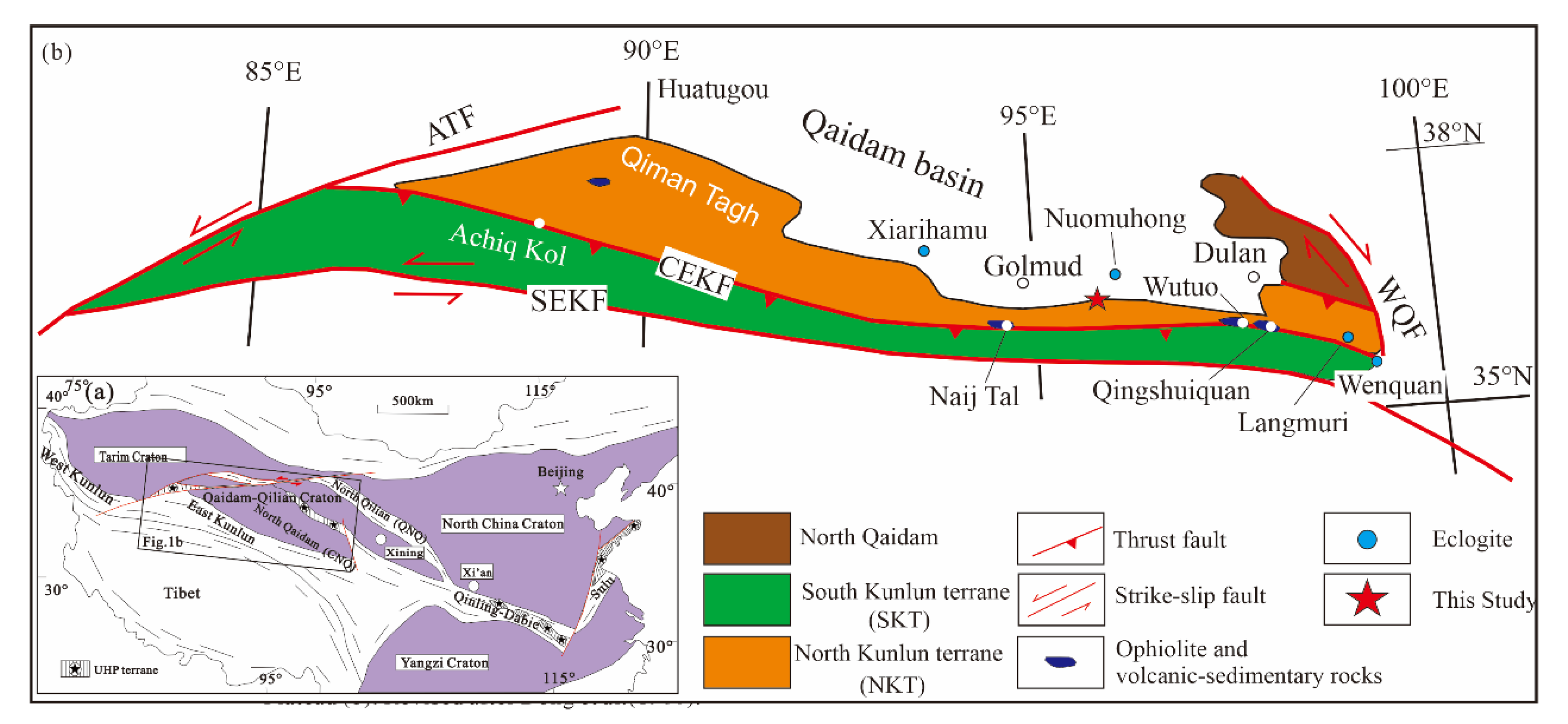
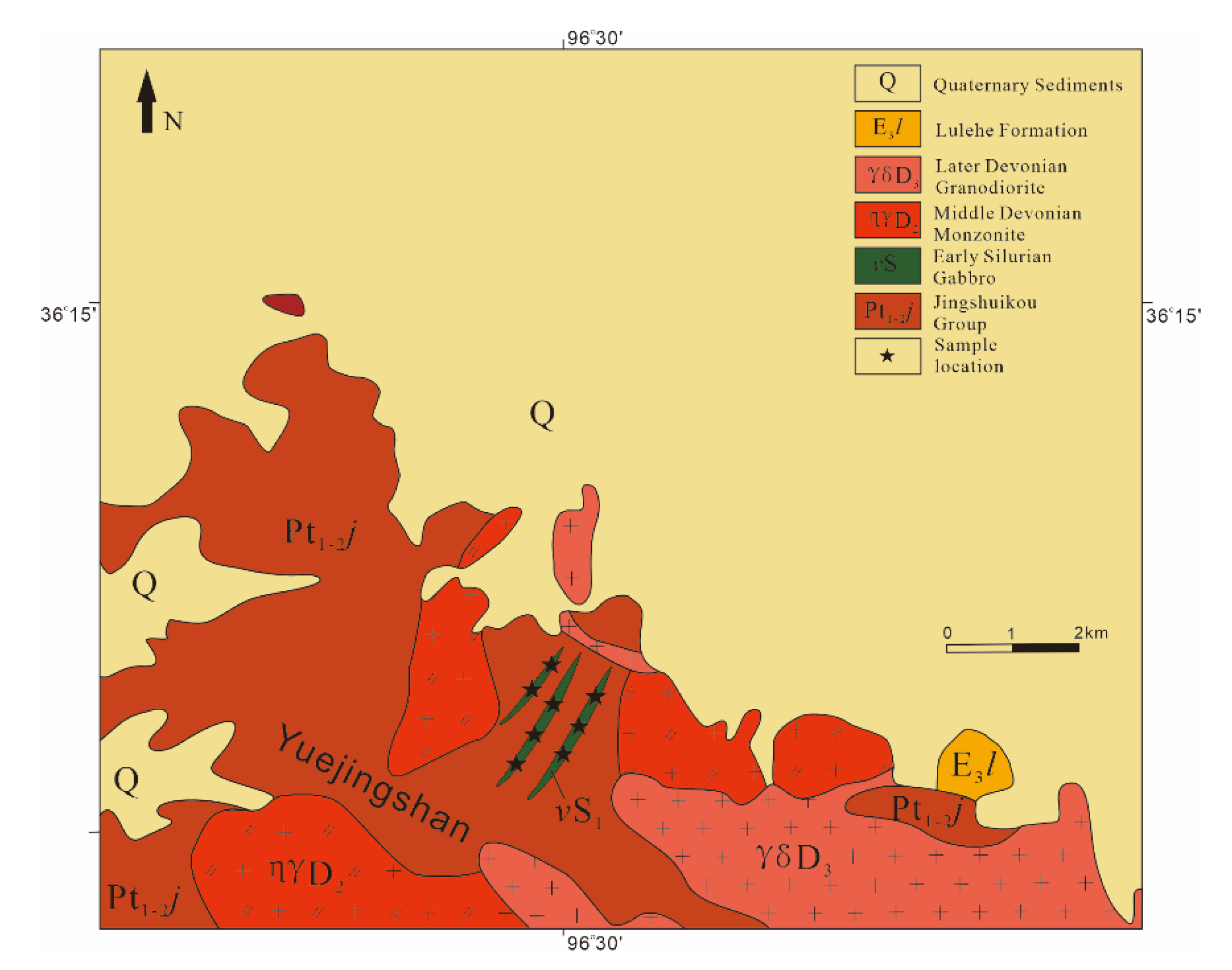
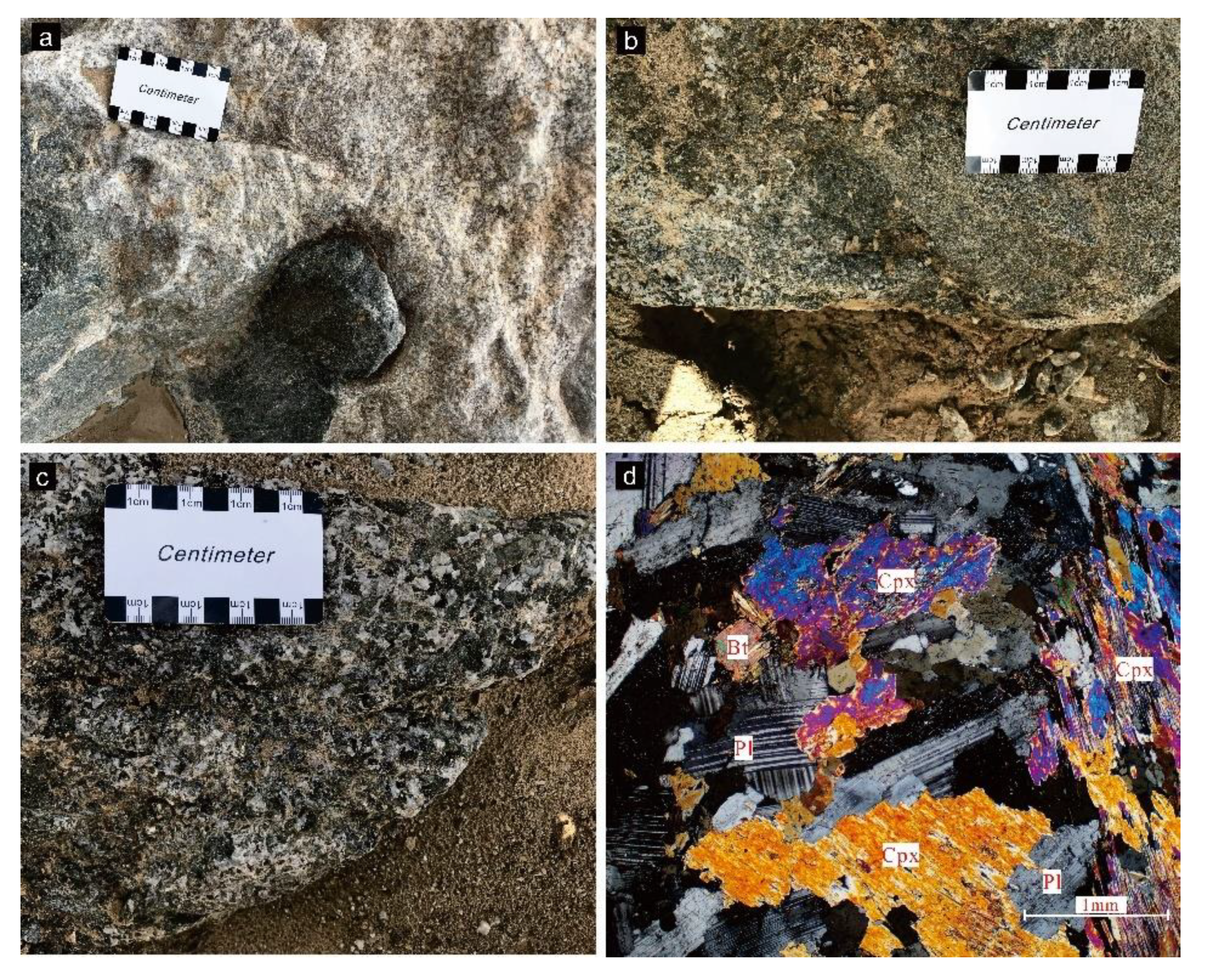
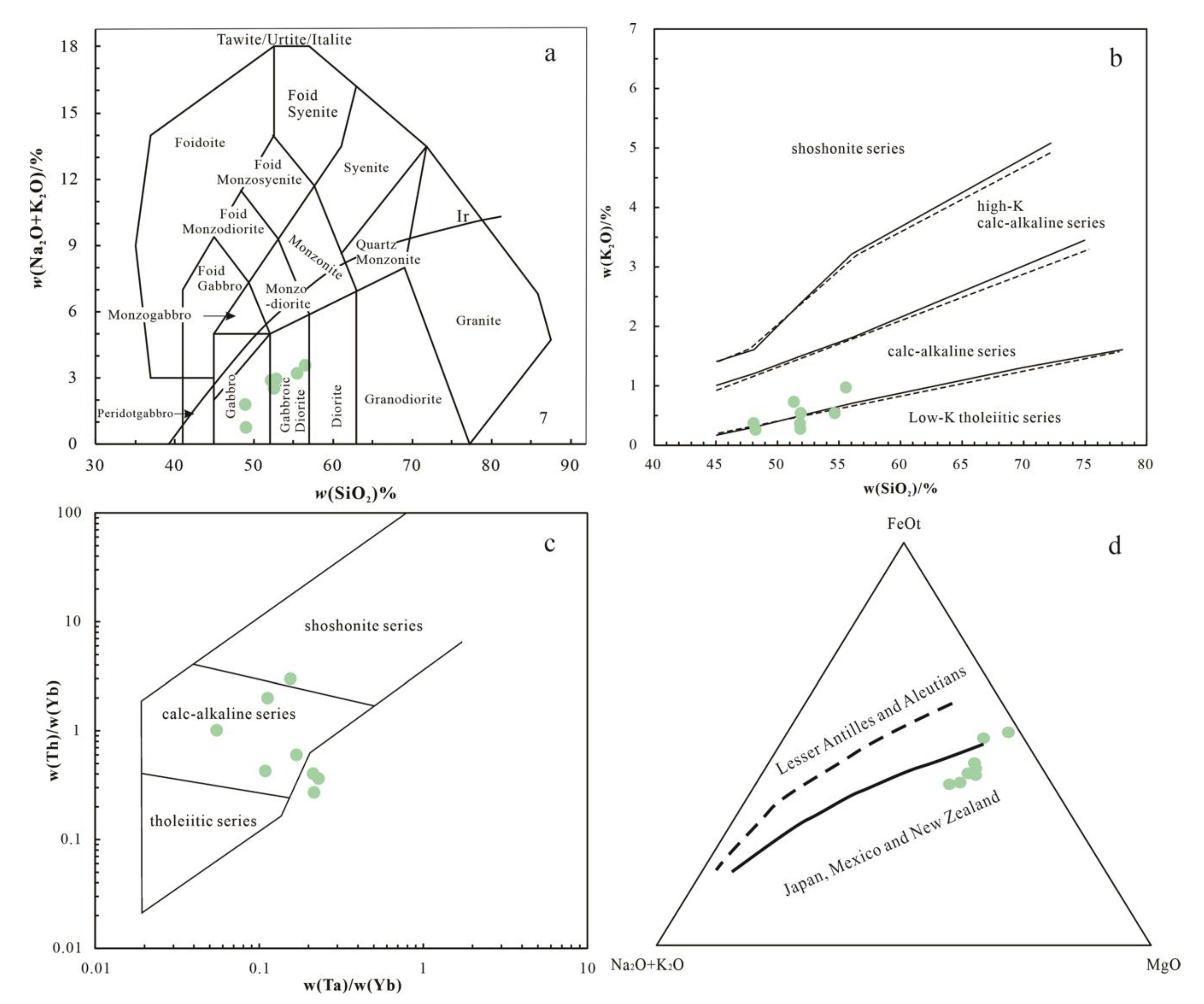
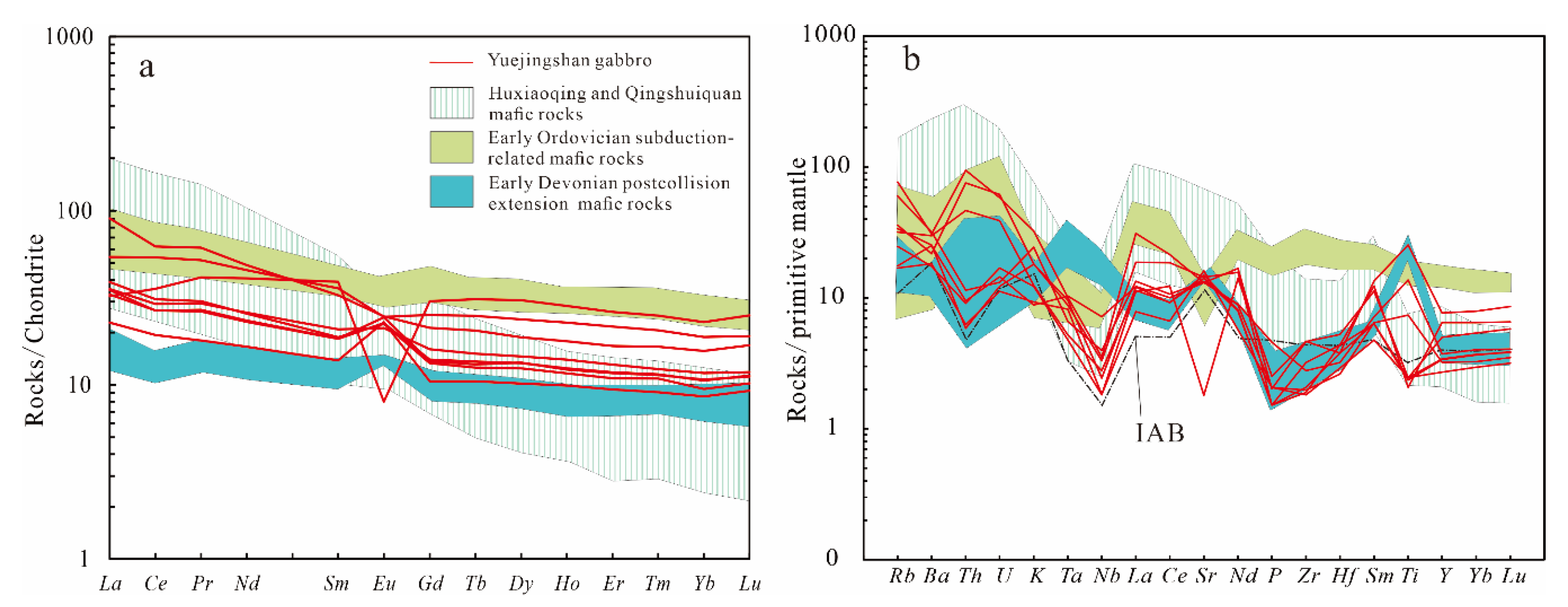
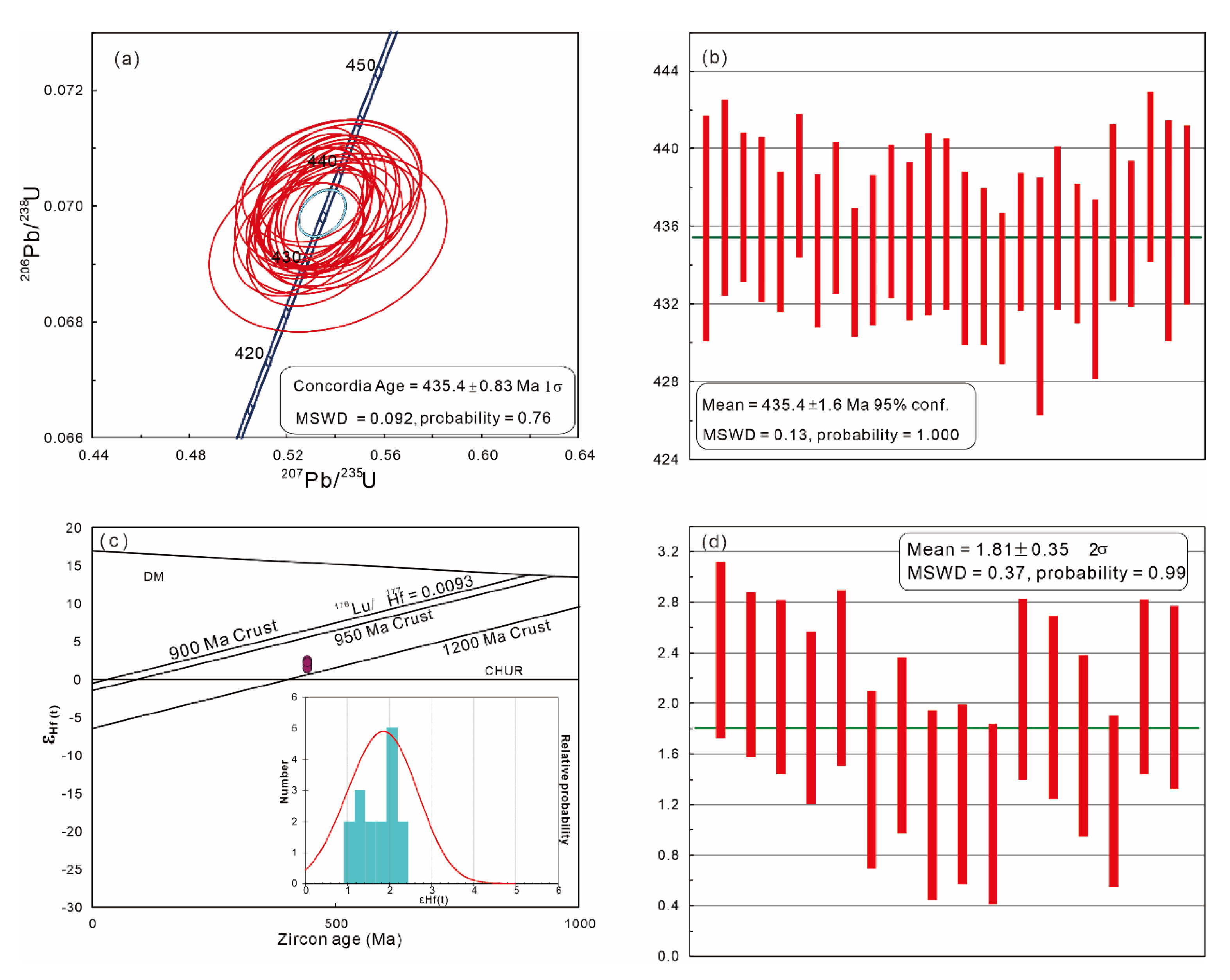
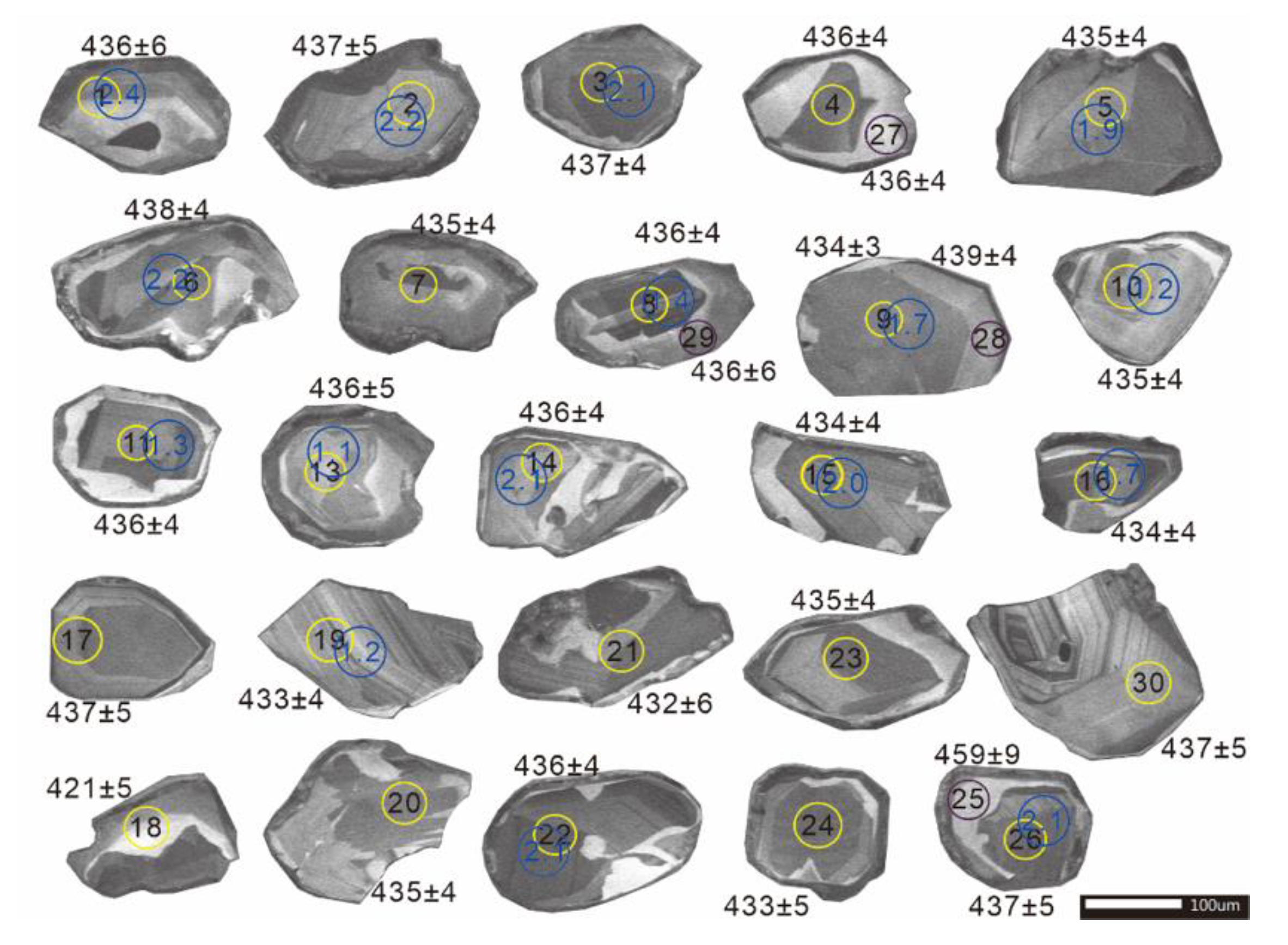
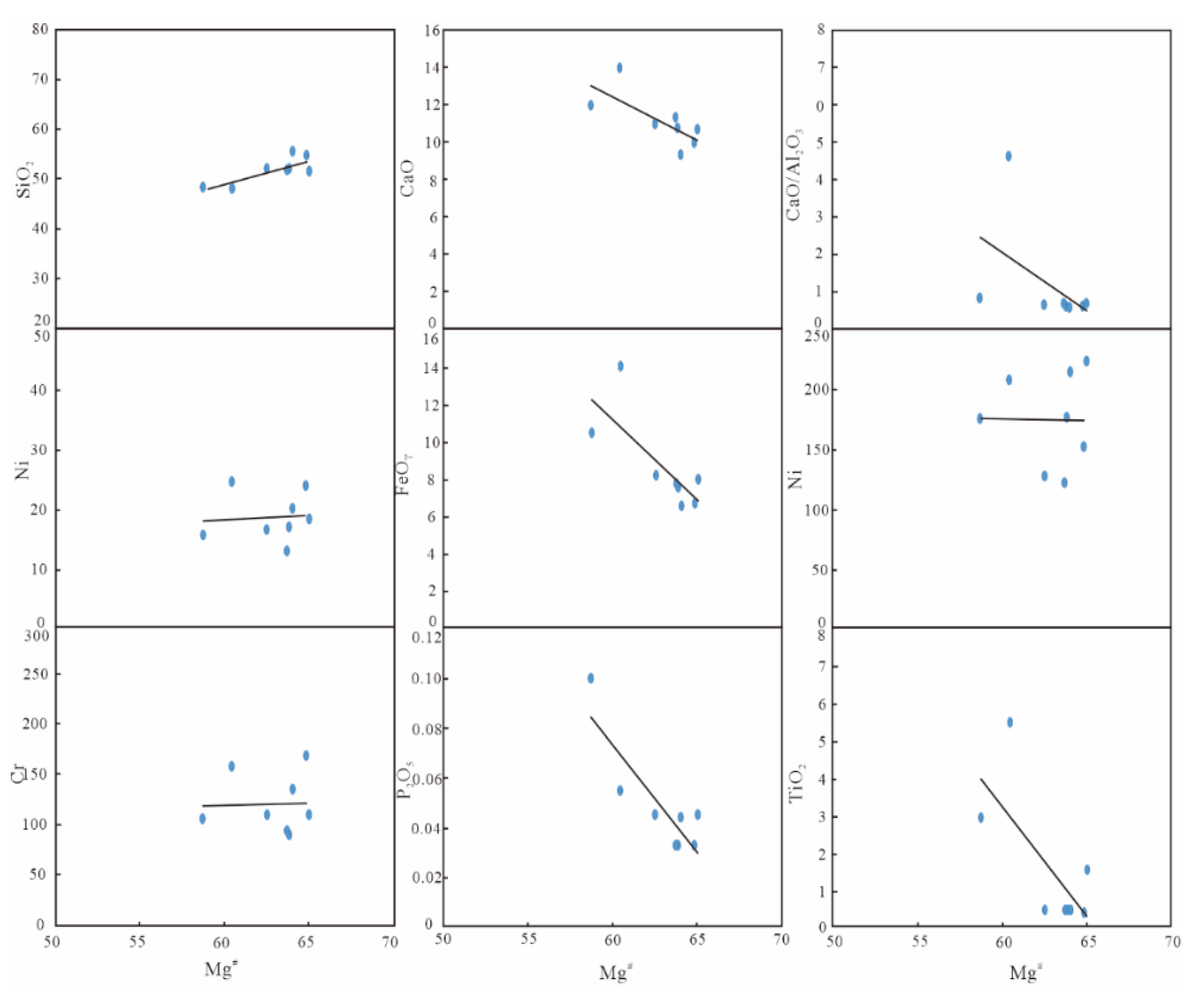
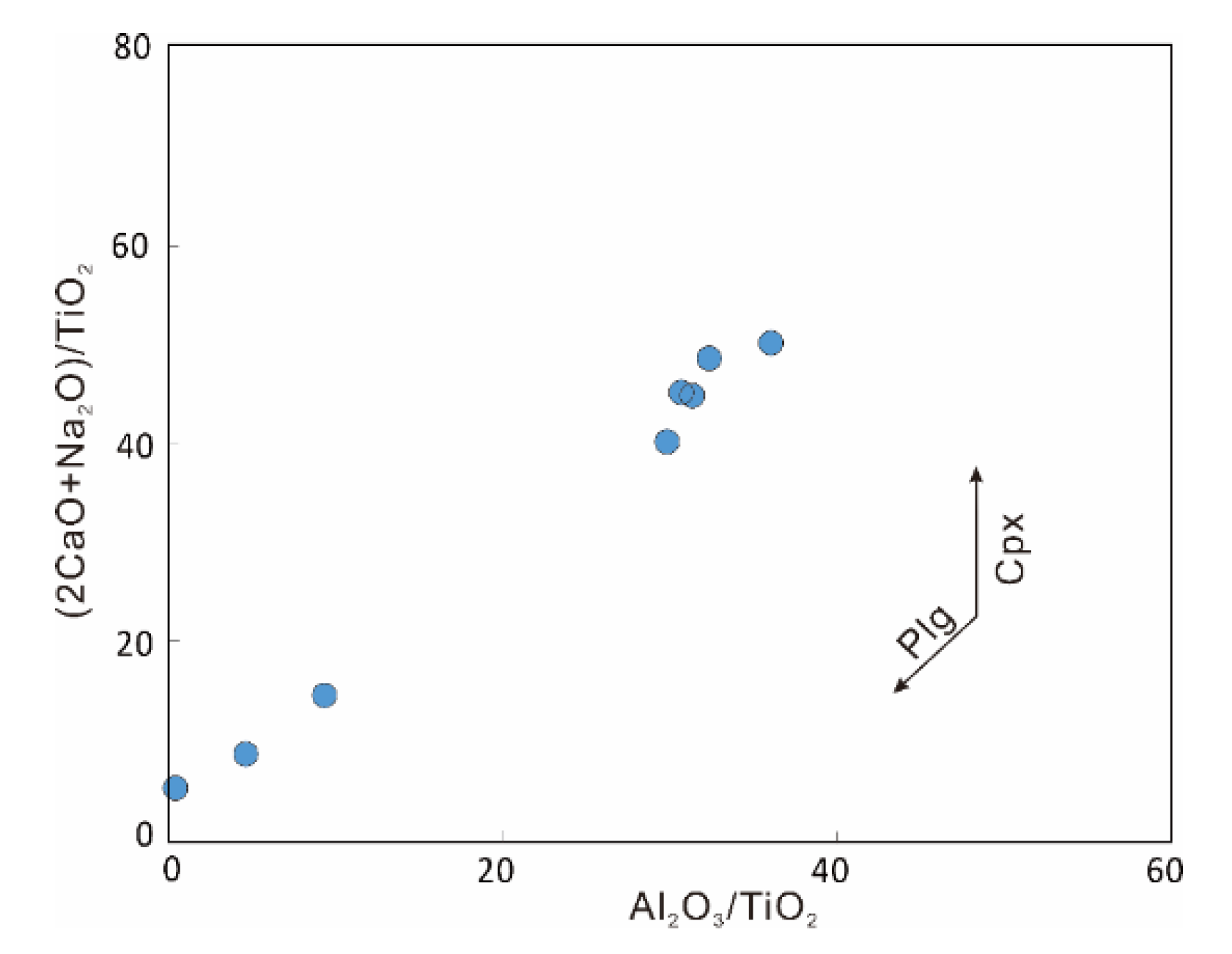
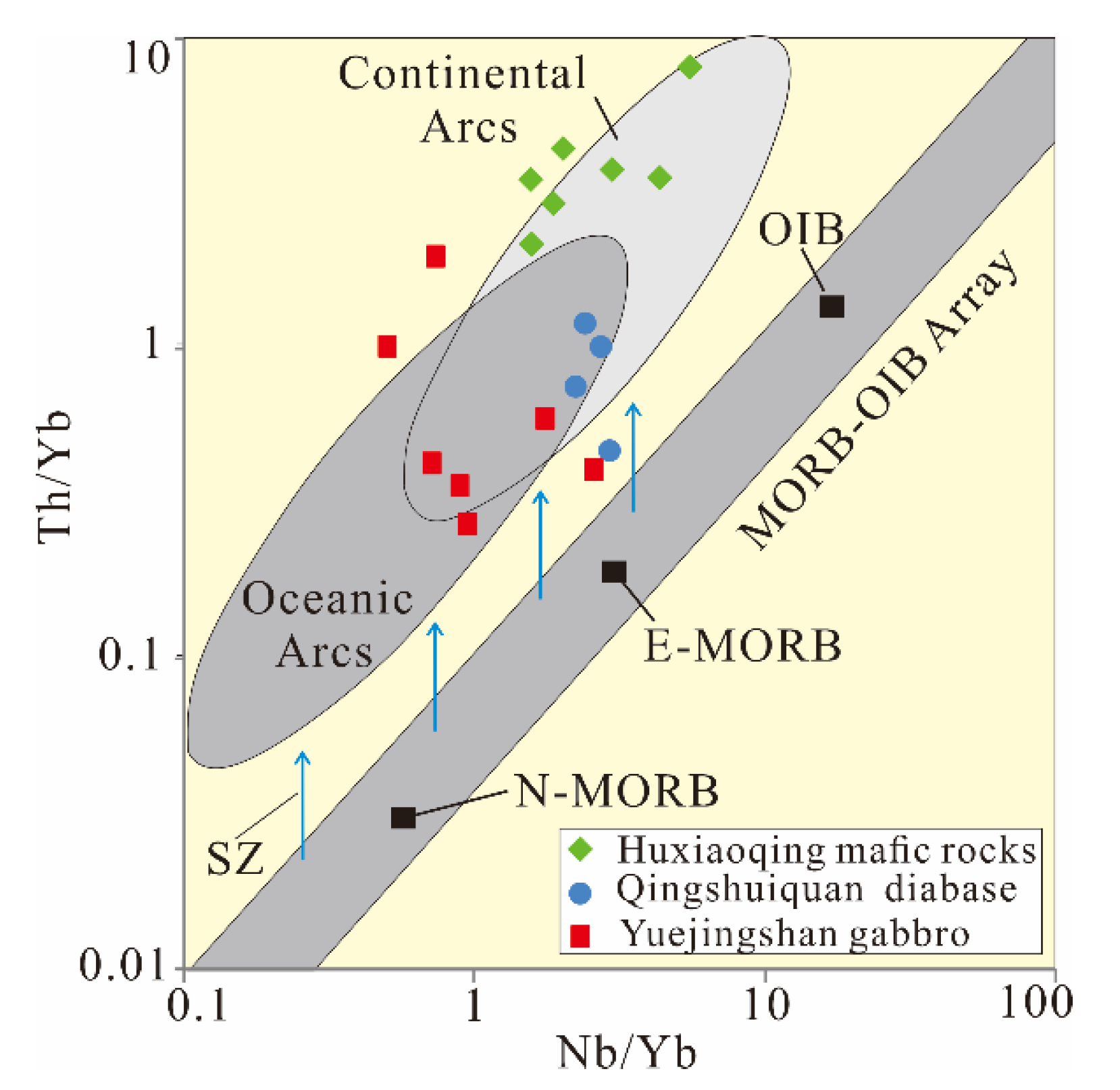
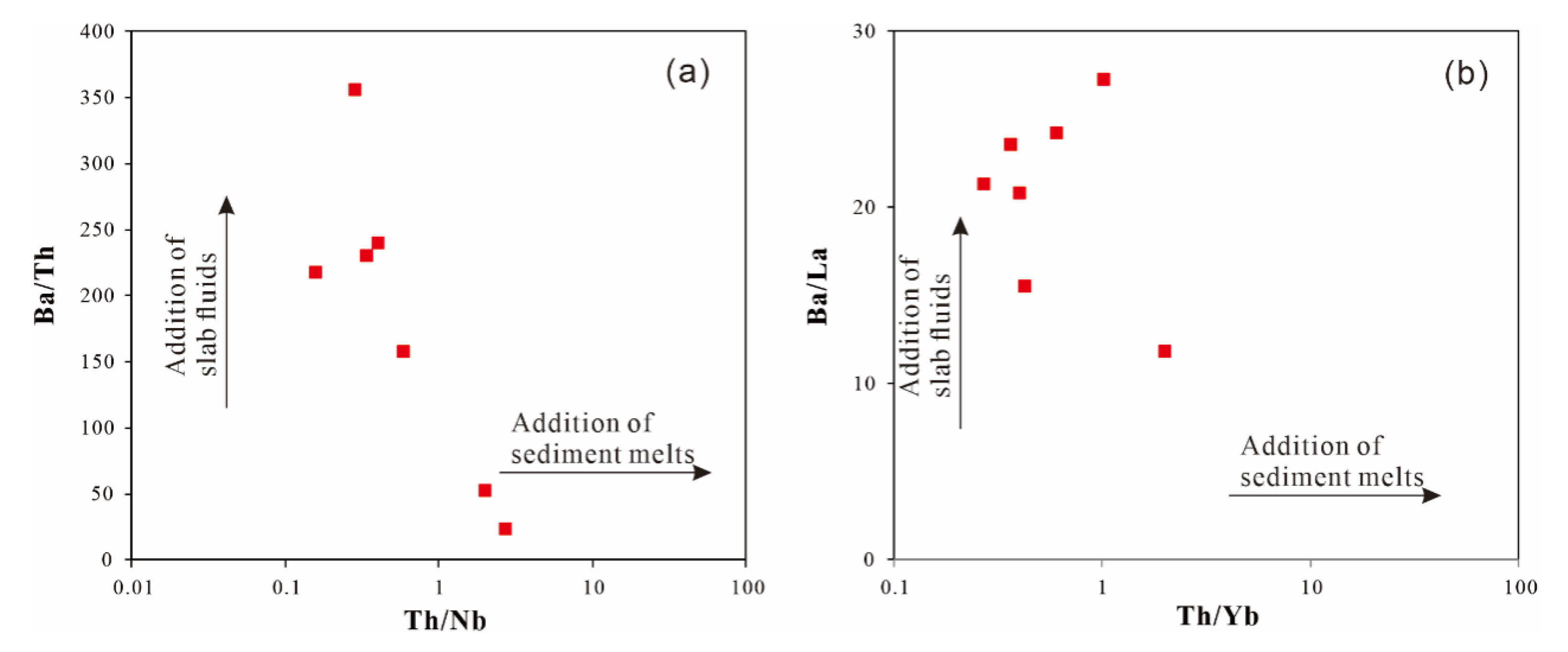
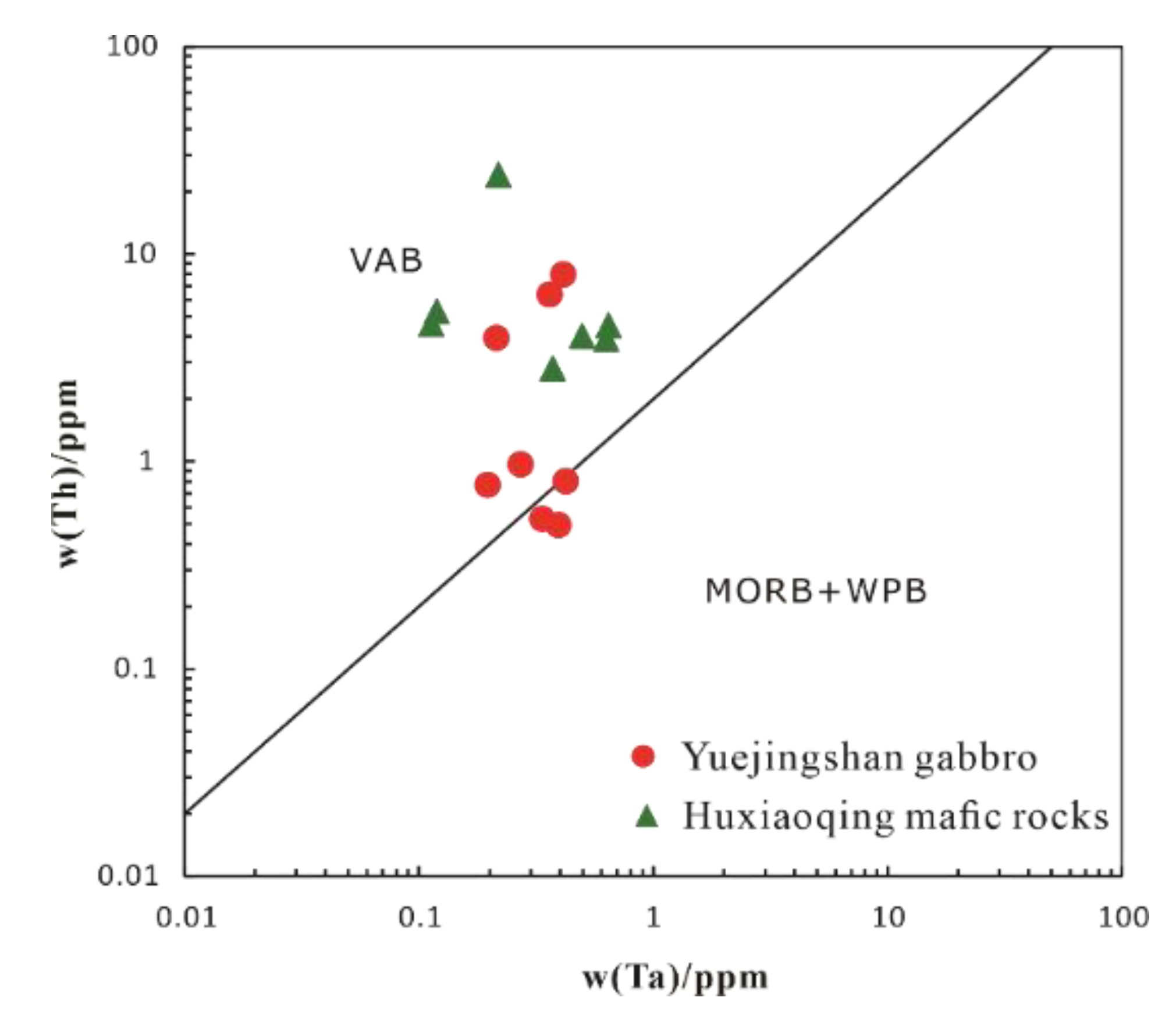
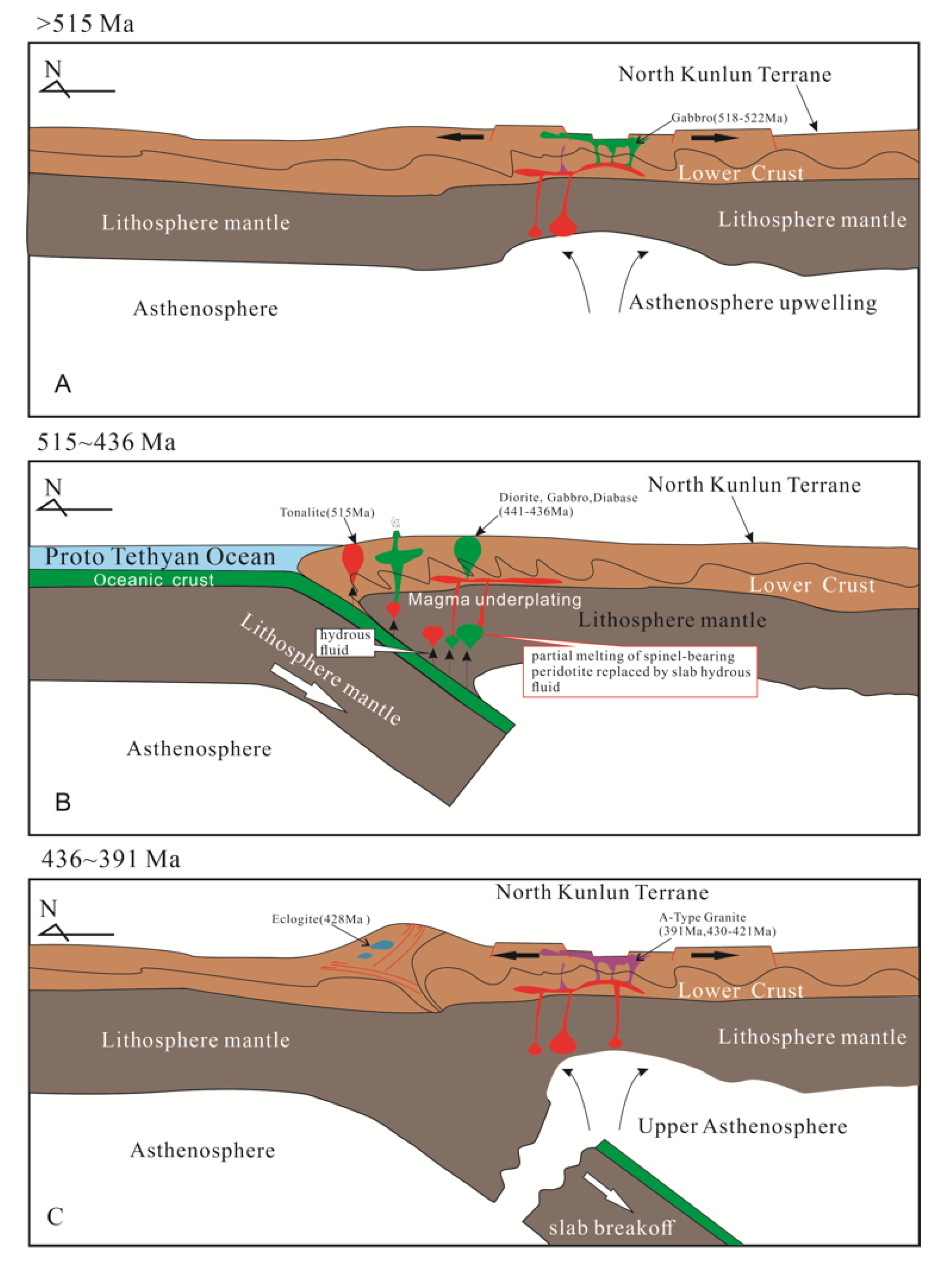
| Samples | YJHC-1 | YJHC-2 | YJHC-3 | YJHC-4 | YJHC-5 | YJHC-6 | YJHC-7 | YJHC-8 |
|---|---|---|---|---|---|---|---|---|
| SiO2 | 51.86 | 51.88 | 48.05 | 51.83 | 54.64 | 48.21 | 55.56 | 51.33 |
| TiO2 | 0.53 | 0.53 | 5.50 | 0.51 | 0.45 | 2.97 | 0.53 | 1.60 |
| Al2O3 | 16.44 | 16.73 | 3.02 | 16.56 | 16.21 | 13.95 | 15.86 | 15.18 |
| Fe2O3 | 0.81 | 1.16 | 1.40 | 1.02 | 0.84 | 1.28 | 0.85 | 0.71 |
| FeO | 7.52 | 6.58 | 12.82 | 6.87 | 6.00 | 9.40 | 5.82 | 7.43 |
| MnO | 0.15 | 0.13 | 0.26 | 0.14 | 0.11 | 0.18 | 0.11 | 0.14 |
| MgO | 7.72 | 7.55 | 12.07 | 7.67 | 6.99 | 8.43 | 6.58 | 8.41 |
| CaO | 10.93 | 10.72 | 13.98 | 11.29 | 9.93 | 11.92 | 9.32 | 10.65 |
| Na2O | 2.18 | 2.33 | 0.35 | 2.11 | 2.60 | 1.49 | 2.53 | 2.08 |
| K2O | 0.28 | 0.55 | 0.38 | 0.37 | 0.55 | 0.27 | 0.98 | 0.73 |
| P2O5 | 0.05 | 0.03 | 0.06 | 0.03 | 0.03 | 0.10 | 0.04 | 0.05 |
| LOI | 0.89 | 1.16 | 0.47 | 0.92 | 0.96 | 0.52 | 1.14 | 1.04 |
| Total | 99.35 | 99.35 | 98.34 | 99.33 | 99.31 | 98.72 | 99.33 | 99.34 |
| A/NK | 4.23 | 3.79 | 3.10 | 4.29 | 3.33 | 5.10 | 3.04 | 3.60 |
| A/CNK | 0.69 | 0.70 | 0.11 | 0.68 | 0.71 | 0.57 | 0.72 | 0.64 |
| A/MF | 0.53 | 0.56 | 0.06 | 0.54 | 0.59 | 0.38 | 0.61 | 0.46 |
| C/MF | 0.64 | 0.65 | 0.50 | 0.67 | 0.66 | 0.60 | 0.65 | 0.59 |
| Mg# | 62.52 | 63.84 | 60.45 | 63.71 | 64.84 | 58.73 | 64.04 | 65.02 |
| Rb | 10.75 | 21.47 | 20.20 | 15.68 | 22.83 | 11.17 | 48.78 | 37.99 |
| Ba | 127.33 | 177.01 | 208.33 | 121.93 | 152.28 | 175.39 | 215.03 | 223.13 |
| Th | 0.53 | 0.50 | 3.96 | 0.77 | 6.42 | 0.81 | 8.03 | 0.97 |
| U | 0.24 | 0.26 | 0.82 | 0.36 | 1.29 | 0.31 | 1.22 | 0.28 |
| Nb | 1.31 | 1.74 | 1.98 | 1.30 | 2.36 | 5.11 | 2.51 | 2.82 |
| Ta | 0.335 | 0.393 | 0.214 | 0.196 | 0.36 | 0.423 | 0.412 | 0.271 |
| Ce | 11.83 | 16.30 | 21.82 | 16.39 | 32.93 | 17.82 | 38.06 | 19.01 |
| Sr | 339.44 | 315.80 | 38.14 | 298.41 | 303.63 | 276.16 | 275.61 | 281.30 |
| Nd | 7.72 | 10.91 | 19.08 | 10.73 | 21.25 | 12.12 | 22.71 | 11.97 |
| P | 196.00 | 144.00 | 240.00 | 144.00 | 144.00 | 436.00 | 192.00 | 196.00 |
| Zr | 20.40 | 21.24 | 52.08 | 23.22 | 36.00 | 31.21 | 51.98 | 22.09 |
| Hf | 0.90 | 1.35 | 1.17 | 1.17 | 1.35 | 0.99 | 1.62 | 0.81 |
| Ti | 3201.00 | 3189.00 | 32,961.00 | 3063.00 | 2692.00 | 17,793.00 | 3177.00 | 9610.00 |
| La | 5.40 | 8.31 | 7.64 | 7.84 | 12.87 | 8.41 | 21.38 | 9.22 |
| Ce | 11.83 | 16.30 | 21.82 | 16.39 | 32.93 | 17.82 | 38.06 | 19.01 |
| Pr | 1.71 | 2.56 | 3.93 | 2.51 | 4.94 | 2.79 | 5.83 | 2.87 |
| Nd | 7.72 | 10.91 | 19.08 | 10.73 | 21.25 | 12.12 | 22.71 | 11.97 |
| Sm | 2.11 | 2.82 | 5.98 | 2.81 | 5.48 | 3.19 | 5.01 | 2.87 |
| Eu | 1.33 | 1.41 | 0.46 | 1.31 | 1.43 | 1.23 | 1.43 | 1.30 |
| Gd | 2.16 | 2.81 | 6.20 | 2.86 | 5.19 | 3.29 | 4.37 | 2.74 |
| Tb | 0.39 | 0.49 | 1.16 | 0.51 | 0.93 | 0.56 | 0.77 | 0.47 |
| Dy | 2.59 | 3.40 | 7.77 | 3.39 | 6.04 | 3.70 | 4.76 | 3.16 |
| Ho | 0.56 | 0.69 | 1.61 | 0.71 | 1.29 | 0.79 | 1.01 | 0.66 |
| Er | 1.56 | 1.93 | 4.34 | 1.96 | 3.58 | 2.16 | 2.77 | 1.80 |
| Tm | 0.23 | 0.29 | 0.64 | 0.29 | 0.52 | 0.31 | 0.42 | 0.28 |
| Yb | 1.46 | 1.82 | 3.90 | 1.80 | 3.20 | 1.99 | 2.66 | 1.61 |
| Lu | 0.24 | 0.28 | 0.64 | 0.29 | 0.49 | 0.30 | 0.43 | 0.26 |
| Y | 12.34 | 15.55 | 34.98 | 15.41 | 29.51 | 17.00 | 22.74 | 14.66 |
| ΣREE | 39.28 | 54.03 | 85.16 | 53.40 | 100.14 | 58.65 | 111.60 | 58.21 |
| LREE | 30.11 | 42.31 | 58.92 | 41.59 | 78.90 | 45.56 | 94.41 | 47.24 |
| HREE | 9.17 | 11.72 | 26.25 | 11.81 | 21.24 | 13.10 | 17.19 | 10.97 |
| LREE/HREE | 3.28 | 3.61 | 2.24 | 3.52 | 3.72 | 3.48 | 5.49 | 4.31 |
| LaN/YbN | 2.66 | 3.27 | 1.41 | 3.12 | 2.88 | 3.04 | 5.77 | 4.11 |
| δEu | 1.91 | 1.53 | 0.23 | 1.42 | 0.82 | 1.16 | 0.94 | 1.42 |
| δCe | 0.95 | 0.87 | 0.98 | 0.91 | 1.01 | 0.90 | 0.84 | 0.91 |
| Nb/La | 0.24 | 0.21 | 0.26 | 0.17 | 0.18 | 0.61 | 0.12 | 0.31 |
| Nb/Ce | 0.11 | 0.11 | 0.09 | 0.08 | 0.07 | 0.29 | 0.07 | 0.15 |
| Nb/Ta | 3.90 | 4.42 | 9.26 | 6.61 | 6.56 | 12.08 | 6.09 | 10.42 |
| Zr/Hf | 22.66 | 15.74 | 44.51 | 19.84 | 26.67 | 31.52 | 32.09 | 27.27 |
| Ce/Y | 0.96 | 1.05 | 0.62 | 1.06 | 1.12 | 1.05 | 1.67 | 1.30 |
| TbN/YbN | 1.22 | 1.22 | 1.35 | 1.28 | 1.32 | 1.29 | 1.31 | 1.33 |
| Th/Yb | 0.36 | 0.27 | 1.02 | 0.43 | 2.00 | 0.41 | 3.02 | 0.60 |
| Th/Nb | 0.41 | 0.29 | 2.00 | 0.60 | 2.72 | 0.16 | 3.20 | 0.34 |
| Ba/Th | 239.80 | 356.16 | 52.58 | 157.53 | 23.73 | 217.61 | 26.79 | 229.79 |
| Ba/La | 23.58 | 21.31 | 27.26 | 15.56 | 11.83 | 20.85 | 10.06 | 24.21 |
| Sr/Nd | 43.96 | 28.96 | 2.00 | 27.82 | 14.29 | 22.78 | 12.14 | 23.50 |
| Spots | 207Pb a | PbTotal | Th b | U b | Th/U b | 206Pb c/238U | 207Pb c/235U | 207Pb c/206Pb | Rho d | 206Pb/238U | 207Pb/235U | 207Pb/206Pb | Concordance | ||||||
|---|---|---|---|---|---|---|---|---|---|---|---|---|---|---|---|---|---|---|---|
| CPS | ppm | ppm | ppm | Ratio | ±1σe | Ratio | ±1σ | Ratio | ±1σ | (Ma) | ±1σ | (Ma) | ±1σ | (Ma) | ±1σ | ||||
| YJHC-01 | 408 | 40.08 | 98.55 | 348.39 | 0.28 | 0.06995 | 0.00097 | 0.53688 | 0.02512 | 0.05648 | 0.00284 | 0.29 | 436 | 6 | 436 | 17 | 472 | 111 | 99% |
| YJHC-02 | 606 | 78.74 | 257.21 | 598.01 | 0.43 | 0.07021 | 0.00084 | 0.53725 | 0.02523 | 0.05551 | 0.00263 | 0.25 | 437 | 5 | 437 | 17 | 432 | 138 | 99% |
| YJHC-03 | 1158 | 158.01 | 542.83 | 1147.79 | 0.47 | 0.07013 | 0.00064 | 0.53527 | 0.01285 | 0.05546 | 0.00141 | 0.38 | 437 | 4 | 435 | 8 | 432 | 57 | 99% |
| YJHC-04 | 990 | 153.51 | 527.52 | 1108.62 | 0.48 | 0.07003 | 0.00071 | 0.53945 | 0.02169 | 0.05585 | 0.00236 | 0.25 | 436 | 4 | 438 | 14 | 456 | 94 | 99% |
| YJHC-05 | 732 | 94.78 | 299.35 | 751.13 | 0.40 | 0.06983 | 0.00060 | 0.52819 | 0.01539 | 0.05497 | 0.00165 | 0.30 | 435 | 4 | 431 | 10 | 409 | 67 | 98% |
| YJHC-06 | 969 | 158.14 | 595.48 | 1086.29 | 0.55 | 0.07032 | 0.00061 | 0.53256 | 0.01581 | 0.05491 | 0.00163 | 0.29 | 438 | 4 | 434 | 10 | 409 | 67 | 98% |
| YJHC-07 | 835 | 108.34 | 366.80 | 814.08 | 0.45 | 0.06976 | 0.00065 | 0.53979 | 0.01836 | 0.05604 | 0.00188 | 0.27 | 435 | 4 | 438 | 12 | 454 | 76 | 99% |
| YJHC-08 | 2030 | 193.34 | 616.88 | 1449.99 | 0.43 | 0.07004 | 0.00065 | 0.52956 | 0.01553 | 0.05485 | 0.00165 | 0.31 | 436 | 4 | 432 | 10 | 406 | 64 | 98% |
| YJHC-09 | 640 | 101.87 | 356.30 | 716.72 | 0.50 | 0.06957 | 0.00054 | 0.52949 | 0.01466 | 0.05528 | 0.00153 | 0.28 | 434 | 3 | 431 | 10 | 433 | 61 | 99% |
| YJHC-10 | 726 | 98.36 | 279.09 | 813.10 | 0.34 | 0.06976 | 0.00064 | 0.53090 | 0.01815 | 0.05511 | 0.00188 | 0.27 | 435 | 4 | 432 | 12 | 417 | 81 | 99% |
| YJHC-11 | 908 | 127.84 | 430.74 | 978.27 | 0.44 | 0.07001 | 0.00065 | 0.53026 | 0.01491 | 0.05482 | 0.00147 | 0.33 | 436 | 4 | 432 | 10 | 406 | 61 | 99% |
| YJHC-12 | 957 | 117.23 | 365.82 | 958.46 | 0.38 | 0.06984 | 0.00067 | 0.53403 | 0.01385 | 0.05557 | 0.00144 | 0.37 | 435 | 4 | 434 | 9 | 435 | 62 | 99% |
| YJHC-13 | 558 | 69.64 | 239.59 | 540.61 | 0.44 | 0.06999 | 0.00077 | 0.53710 | 0.01932 | 0.05548 | 0.00189 | 0.31 | 436 | 5 | 437 | 13 | 432 | 76 | 99% |
| YJHC-14 | 845 | 97.76 | 320.63 | 751.68 | 0.43 | 0.06999 | 0.00073 | 0.54189 | 0.01610 | 0.05609 | 0.00161 | 0.35 | 436 | 4 | 440 | 11 | 457 | 63 | 99% |
| YJHC-15 | 1030 | 104.98 | 323.36 | 843.41 | 0.38 | 0.06970 | 0.00074 | 0.54178 | 0.02323 | 0.05614 | 0.00233 | 0.25 | 434 | 4 | 440 | 15 | 457 | 91 | 98% |
| YJHC-16 | 1066 | 123.13 | 370.94 | 996.53 | 0.37 | 0.06963 | 0.00066 | 0.53716 | 0.01748 | 0.05579 | 0.00186 | 0.29 | 434 | 4 | 437 | 12 | 443 | 74 | 99% |
| YJHC-19 | 713 | 73.90 | 229.30 | 596.73 | 0.38 | 0.06943 | 0.00065 | 0.52479 | 0.01757 | 0.05462 | 0.00180 | 0.28 | 433 | 4 | 428 | 12 | 398 | 79 | 98% |
| YJHC-20 | 1025 | 136.49 | 501.54 | 945.67 | 0.53 | 0.06984 | 0.00058 | 0.53371 | 0.01392 | 0.05514 | 0.00143 | 0.32 | 435 | 4 | 434 | 9 | 417 | 55 | 99% |
| YJHC-21 | 1082 | 106.30 | 362.70 | 809.95 | 0.45 | 0.06937 | 0.00102 | 0.53699 | 0.03234 | 0.05564 | 0.00332 | 0.24 | 432 | 6 | 436 | 21 | 439 | 133 | 99% |
| YJHC-22 | 1728 | 224.52 | 816.17 | 1616.77 | 0.50 | 0.06996 | 0.00070 | 0.53550 | 0.01332 | 0.05509 | 0.00131 | 0.40 | 436 | 4 | 435 | 9 | 417 | 58 | 99% |
| YJHC-23 | 1257 | 147.01 | 538.22 | 1064.23 | 0.51 | 0.06974 | 0.00060 | 0.53854 | 0.01328 | 0.05578 | 0.00139 | 0.35 | 435 | 4 | 437 | 9 | 443 | 56 | 99% |
| YJHC-24 | 768 | 94.57 | 343.30 | 704.55 | 0.49 | 0.06944 | 0.00076 | 0.53265 | 0.01908 | 0.05546 | 0.00203 | 0.31 | 433 | 5 | 434 | 13 | 432 | 81 | 99% |
| YJHC-26 | 957 | 130.27 | 484.79 | 925.38 | 0.52 | 0.07009 | 0.00075 | 0.53486 | 0.01730 | 0.05508 | 0.00181 | 0.33 | 437 | 5 | 435 | 11 | 417 | 74 | 99% |
| YJHC-27 | 713 | 102.17 | 332.99 | 767.02 | 0.43 | 0.06990 | 0.00062 | 0.54729 | 0.01570 | 0.05644 | 0.00164 | 0.31 | 436 | 4 | 443 | 10 | 478 | 32 | 98% |
| YJHC-28 | 724 | 89.70 | 284.45 | 713.62 | 0.40 | 0.07039 | 0.00073 | 0.53858 | 0.02444 | 0.05523 | 0.00247 | 0.23 | 439 | 4 | 437 | 16 | 420 | 98 | 99% |
| YJHC-29 | 1229 | 113.98 | 238.54 | 1078.95 | 0.22 | 0.06993 | 0.00094 | 0.52801 | 0.01563 | 0.05447 | 0.00157 | 0.45 | 436 | 6 | 430 | 10 | 391 | 65 | 98% |
| YJHC-30 | 691 | 77.84 | 253.85 | 627.90 | 0.40 | 0.07007 | 0.00076 | 0.53650 | 0.01875 | 0.05523 | 0.00193 | 0.31 | 437 | 5 | 436 | 12 | 420 | 78 | 99% |
| Spots | 176Hf/177Hf | 1σ | 176Lu/177Hf | 1σ | 176Yb/177Hf | 1σ | Age (Ma) | 176Hf/177Hf (t) | εHf(t) | 1σ | TDM1 | TDM2 | fLu/Hf |
|---|---|---|---|---|---|---|---|---|---|---|---|---|---|
| YJHC-01 | 0.282575 | 0.000012 | 0.000586 | 0.000005 | 0.019114 | 0.000230 | 436 | 0.282570 | 2.451123 | 0.698450 | 0.95 | 1.16 | −0.98 |
| YJHC-02 | 0.282568 | 0.000010 | 0.000358 | 0.000008 | 0.011535 | 0.000245 | 437 | 0.282565 | 2.275424 | 0.651632 | 0.95 | 1.17 | −0.99 |
| YJHC-03 | 0.282566 | 0.000012 | 0.000507 | 0.000004 | 0.016676 | 0.000101 | 437 | 0.282562 | 2.177404 | 0.685086 | 0.96 | 1.17 | −0.98 |
| YJHC-04 | 0.282561 | 0.000012 | 0.000791 | 0.000001 | 0.026815 | 0.000096 | 436 | 0.282555 | 1.910605 | 0.681251 | 0.97 | 1.19 | −0.98 |
| YJHC-05 | 0.282568 | 0.000012 | 0.000562 | 0.000001 | 0.017963 | 0.000088 | 435 | 0.282564 | 2.204613 | 0.693689 | 0.96 | 1.17 | −0.98 |
| YJHC-06 | 0.282545 | 0.000012 | 0.000529 | 0.000020 | 0.017255 | 0.000715 | 438 | 0.282541 | 1.467534 | 0.700865 | 0.99 | 1.21 | −0.98 |
| YJHC-07 | 0.282554 | 0.000012 | 0.000582 | 0.000003 | 0.019450 | 0.000128 | 435 | 0.282549 | 1.671190 | 0.695060 | 0.98 | 1.20 | −0.98 |
| YJHC-08 | 0.282541 | 0.000014 | 0.000697 | 0.000013 | 0.022012 | 0.000405 | 436 | 0.282536 | 1.223624 | 0.748791 | 1.00 | 1.23 | −0.98 |
| YJHC-09 | 0.282546 | 0.000013 | 0.001035 | 0.000029 | 0.034477 | 0.001021 | 434 | 0.282538 | 1.265352 | 0.706653 | 1.00 | 1.22 | −0.97 |
| YJHC-10 | 0.282539 | 0.000013 | 0.000660 | 0.000003 | 0.020823 | 0.000166 | 435 | 0.282534 | 1.131614 | 0.712386 | 1.00 | 1.23 | −0.98 |
| YJHC-11 | 0.282566 | 0.000013 | 0.000594 | 0.000002 | 0.018700 | 0.000092 | 436 | 0.282561 | 2.137195 | 0.714768 | 0.96 | 1.18 | −0.98 |
| YJHC-12 | 0.282561 | 0.000014 | 0.000443 | 0.000001 | 0.014240 | 0.000057 | 435 | 0.282557 | 1.974358 | 0.723604 | 0.96 | 1.18 | −0.99 |
| YJHC-13 | 0.282554 | 0.000013 | 0.000711 | 0.000007 | 0.023546 | 0.000257 | 436 | 0.282549 | 1.688117 | 0.718018 | 0.98 | 1.20 | −0.98 |
| YJHC-14 | 0.282541 | 0.000011 | 0.000516 | 0.000006 | 0.016402 | 0.000217 | 436 | 0.282536 | 1.255510 | 0.676370 | 0.99 | 1.22 | −0.98 |
| YJHC-15 | 0.282565 | 0.000012 | 0.000433 | 0.000004 | 0.013554 | 0.000178 | 434 | 0.282562 | 2.115202 | 0.687449 | 0.96 | 1.17 | −0.99 |
| YJHC-16 | 0.282567 | 0.000013 | 0.000908 | 0.000002 | 0.029073 | 0.000104 | 434 | 0.282560 | 2.031208 | 0.721509 | 0.97 | 1.18 | −0.97 |
© 2020 by the authors. Licensee MDPI, Basel, Switzerland. This article is an open access article distributed under the terms and conditions of the Creative Commons Attribution (CC BY) license (http://creativecommons.org/licenses/by/4.0/).
Share and Cite
Zhou, W.; Li, H.; Chang, F.; Lv, X. The Early Silurian Gabbro in the Eastern Kunlun Orogenic Belt, Northeast Tibet: Constraints on the Proto-Tethyan Ocean Closure. Minerals 2020, 10, 794. https://doi.org/10.3390/min10090794
Zhou W, Li H, Chang F, Lv X. The Early Silurian Gabbro in the Eastern Kunlun Orogenic Belt, Northeast Tibet: Constraints on the Proto-Tethyan Ocean Closure. Minerals. 2020; 10(9):794. https://doi.org/10.3390/min10090794
Chicago/Turabian StyleZhou, Wenxiao, Haiquan Li, Feng Chang, and Xinbiao Lv. 2020. "The Early Silurian Gabbro in the Eastern Kunlun Orogenic Belt, Northeast Tibet: Constraints on the Proto-Tethyan Ocean Closure" Minerals 10, no. 9: 794. https://doi.org/10.3390/min10090794
APA StyleZhou, W., Li, H., Chang, F., & Lv, X. (2020). The Early Silurian Gabbro in the Eastern Kunlun Orogenic Belt, Northeast Tibet: Constraints on the Proto-Tethyan Ocean Closure. Minerals, 10(9), 794. https://doi.org/10.3390/min10090794







